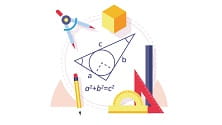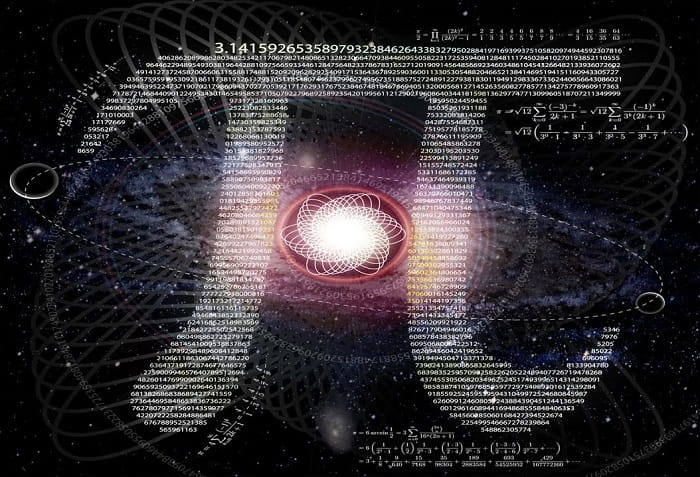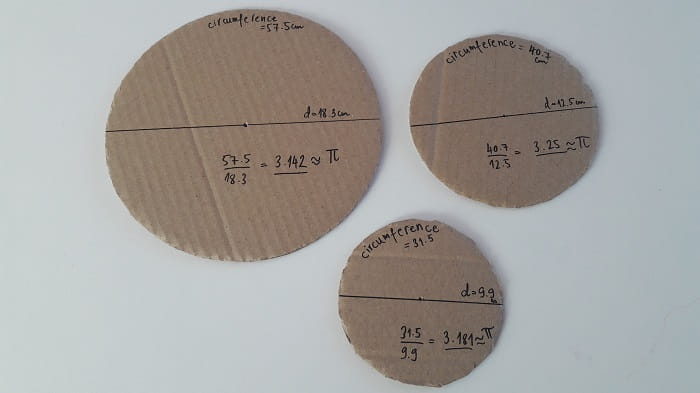You have probably heard of the number Pi, that mysterious constant that goes on forever. We know it from mathematical formulas, but what is it exactly? Let’s try to get some clarification through a fun activity. We hope it will help you forever remember the formula for the circle circumference!
Article Contents
1. What is Pi?2. Some interesting tidbits about pi
3. The significance of Pi in Modern Science
4. Materials needed for demonstrating Pi
4. Instructions on how to do demonstrate Pi
4. What will you develop and learn while exploring Pi
What is Pi?
Let’s start with a little history lesson. People were measuring circles from ancient times. And while measuring, they noticed peculiar rule. They measured the diameter – line connecting two dots on the circle through the center. They measured circumference – the length of the circle if it would be opened up and formed a straight line. The ratio of the circumference of a circle to its diameter was always around 3. No matter the size of the circle. There are written sources from Babylon and Egypt, dating back to 1900 BC, in which they approximate this value to be 25/8 (3.125).
Archimedes, the famous Greek mathematician, took it even further. He refined measurement by using a clever method – calculating perimeters of two polygons, one inscribed and one circumscribed to a circle. Polygon is just a 2D shape formed from the straight lines. The name of the polygon tells you how many sides the shape has. For example, a triangle has 3 sides, quadrilateral 4,
If you are interested in finding out more about this concept, we recommend a great visualization from the Wolfram Alfa where you can see how the pi is being approximated with the polygons.
An invention of calculus brought new ways to calculate pi and the advent of computing made it simpler and faster. Nowadays, pi is calculated to 22.4 trillion (!!!) digits using computer programs and various clever algorithms. It’s mostly for bragging rights though. NASA is rounding pi to 15 digits for all their calculations. And to calculate the circumference of a visible universe (with a radius of 46 billion light-years) you would need only about 40 digits to get the accuracy equal to the diameter of the smallest atom (H). That’s amazing!
Some interesting tidbits about pi
Pi can never be expressed exactly in the terms of a fraction, like one integer over the other. That means it is an irrational number. And indeed, it goes on forever, without repeating patterns of digits. 3.14159265358979323846… It’s already been calculated to quadrillion decimal places!
How do we know it is irrational and by that definition never ends? Well, that’s been proved in 18. century by Johann Heinrich Lambert by using a combination of trigonometry and oppositional logic. He also correctly suggested that pi is a transcendental number. That means that no quadratic equation (example x2 − 4x + 2 = 0) can have a pi as its solution.
And although we know it as pi (Greek letter 𝛑), this name first appeared in 18. Century. It was also called Archimedes’ constant. You can find any pattern of numbers included in forever going digits of pi. If you want to test on which digit of pi can you find your birthday or any other number, check this great website: mypiday.
The significance of Pi in Modern Science
As you can imagine, pi is very important when dealing with round 2d and 3d shapes. It’s needed in any task that deals with calculating volume and area of spheres, cylinders, cones, and similar shapes. It is also used to determine the rotations of any circular objects.
That’s why it’s very important in astronomy – determining properties of planetary bodies. NASA is using pi in many of their exploration quests. For example, pi was used in modeling distributions for the rover’s landing location on Mars. It also helps to determine which newly discovered planets can support life. For that, they must be in the optimal position from the star, not too close and not too far. By using pi in their calculation, scientists can approximate the planet’s location and is it in the habitable area. Calculating distance between stars is also using this special kind of geometry, “spherical geometry” that heavily utilizes pi.
Besides use in geometry, pi has its uses in number theory as well as statistics. It is really all around us (pun intended!).
And now to experiment! We will try to get our approximation of pi using the simplest method possible. The purpose is just to give you some intuition on what the pi is. After this, we bet you’ll always remember the formula for the circle circumference!
Materials needed for demonstrating Pi
- Cardboard
- Divider
- Ruler
- Scissors
- Yarn or string
- Measuring tape
Instructions on how to do demonstrate Pi
You can check a video on how to make a simple demonstration of number Pi at the beginning of the article. Or if you prefer reading, continue and see the instructions below.
- Take a piece of cardboard and draw a circle by using the divider.
- Cut out the circle with the scissors.
- Draw a line from one side of the circle to the other through the center – that’s the diameter of the circle. Measure it and write down the result.
- Take a piece of yarn and measure how much length of it you need to go all around the circle. That’s the circumference of a circle.
- Repeat this process a few times with different sized circles.
- Calculate the ratio of diameter to circumference. Is it close to 3? It should actually be 3.14159… It’s pi! Probably not perfectly accurate because of the imprecise way of measuring, but should be close.
- Do you understand the formula for the circle’s circumference now? C = 2r * pi! Hope it will be easier to remember now!
What will you develop and learn while exploring Pi
- Gain intuition for the circle’s circumference formula
- What is pi
- What are irrational numbers
- How is pi used in important scientific work
- Math is fun!
Go eat your pie, you deserved it! Joking aside, we hope you enjoyed this exploration of the amazing number pi. if you are interested in more fun math, check out how to make and solve Hanoi tower. Or dive into programming with Scratch! March 14 (official pi day) is also a birthday of Albert Einstein so in his honor do some physics experiment. We recommend you explore crushing cans with air and amaze your friends with this feat of strength!
If you’re searching for some great STEM Activities for Kids and Child development tips, you’re in the right place! Check the Categories below to find the right activity for you.

STEM Science
Videos, guides and explanations about STEM Science in a step-by-step way with materials you probably already have at your home. Find new Science ideas.
Read more
STEM Technology
Videos, guides and explanations about STEM Technology in a step-by-step way with materials you probably already have at your home. Find new Technology ideas.
Read more
STEM Engineering
Videos, guides and explanations about STEM Engineering in a step-by-step way with materials you probably already have at your home. New Engineering ideas!
Read more
STEM Math
Videos, guides and explanations about STEM Math in a step-by-step way with materials you probably already have at your home. Find new Mathematics ideas.
Read more
Psychology
Find out all about development psychology topics that you always wanted to know. Here are articles from child psychology and development psychology overall.
Read more
First year of Child’s Life
Following a Child’s development every month from its birth. Personal experiences and tips on how to cope with challenges that you will face in parenting.
Read more




3 thoughts on “Explore the Mysterious Number Pi (π)”